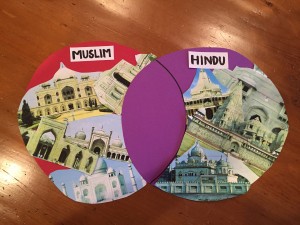“Labeling Islam” employs the exclusive yet overlapping structure of the Venn diagram to demonstrate the issues with how religion operated as a label to categorize Indo-Islamic art and architecture. Bhatt and Patel’s paper “How Buildings Divide and Unite Us” inspired my portrayal of architecture as what the authors describe as ‘racial art’. The paper analyzes the controversial yet complex relationship between religious buildings as ‘racial art’ and religious identity. Labels were used as a means of gaining authority by asserting dominance of one race over another. Bhatt stresses how buildings that demonstrated a confluence of Hindu and Islamic building traditions were not viewed in geographical or cultural terms, but rather as a declaration of political dominance of Islam over Hindu India. This categorization of Indo-Islamic architecture reflects the issue of perspective and authority. The categorization of religious buildings depended on what authority was doing the labeling. Colonial historians inappropriately used these religious labels in adherence to buildings in order to divide the Hindu and Muslim communities and maintain control over India.
Bhatt and Patel examine the village of Mandal to show how the residents’ religious identification with their buildings does not reflect the mutually exclusive function historians cast on these buildings. The integration of mosques in Hindu and Muslim communities forced the communities to oversee any labels in order to co-exist. The close proximity of the two communities created a mutual dependence on each other that came to be centered around the religious buildings. Thus, Bhatt calls for a historical reassessment of the religious labeling of buildings by referencing the integration of buildings into the daily lives of both Hindus and Muslims in the village of Mandel.
In my venn diagram, I wanted to convey the ways in which authorities have manipulated Islam in order to fulfill their own interests. They give the secular entity of architecture a religious label in hopes of dividing the two communities. This demonstration of inappropriate religious adherence to non-religious aspects of society can also be seen in the Bengali language movement. The labels of languages as Islamic, like art, were a reflection of one’s identity and therefore a way of asserting authority. Using Indo-Islamic architecture, I display the categorization of famous religious buildings as ‘Hindu’ or ‘Muslim’ as a statement of political authority. Many of the buildings included architectural elements, like pillars and domes, that resemble both Hindu and Muslim styles. Despite this overlap of styles, the buildings are still put into discrete, exclusive categories. The Taj Mahal was an example of how, although the building reflects a fusion of Hindu and Persian architectural elements, British historians labeled it as Muslim art in order to create boundaries between religious communities.

im indonesian.. here many building such as mosque that inspiring by original culture. and many activities such as gamelan or marawis that inspirate by original culture. before islam come to indonesia, hindu is come too long here..